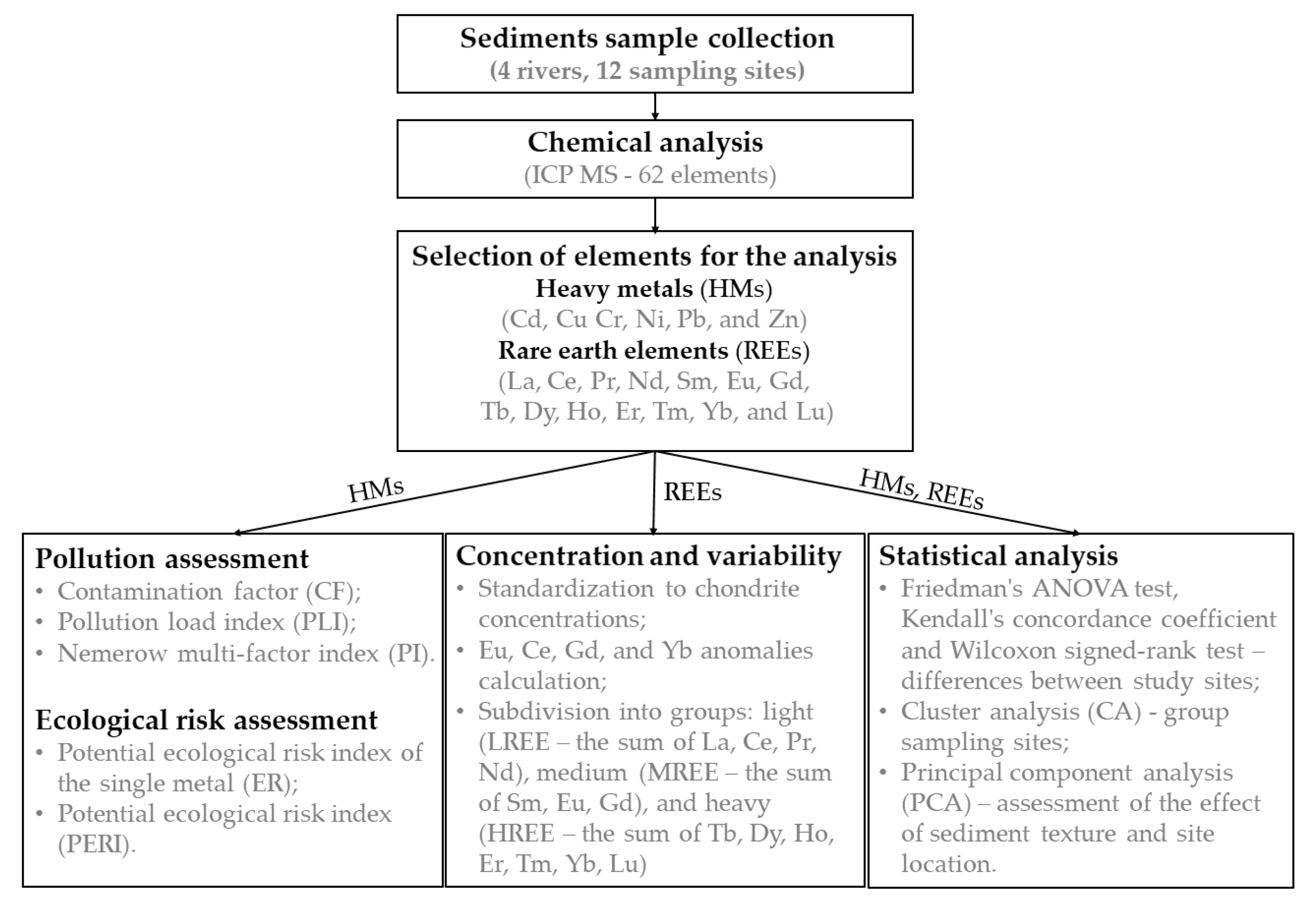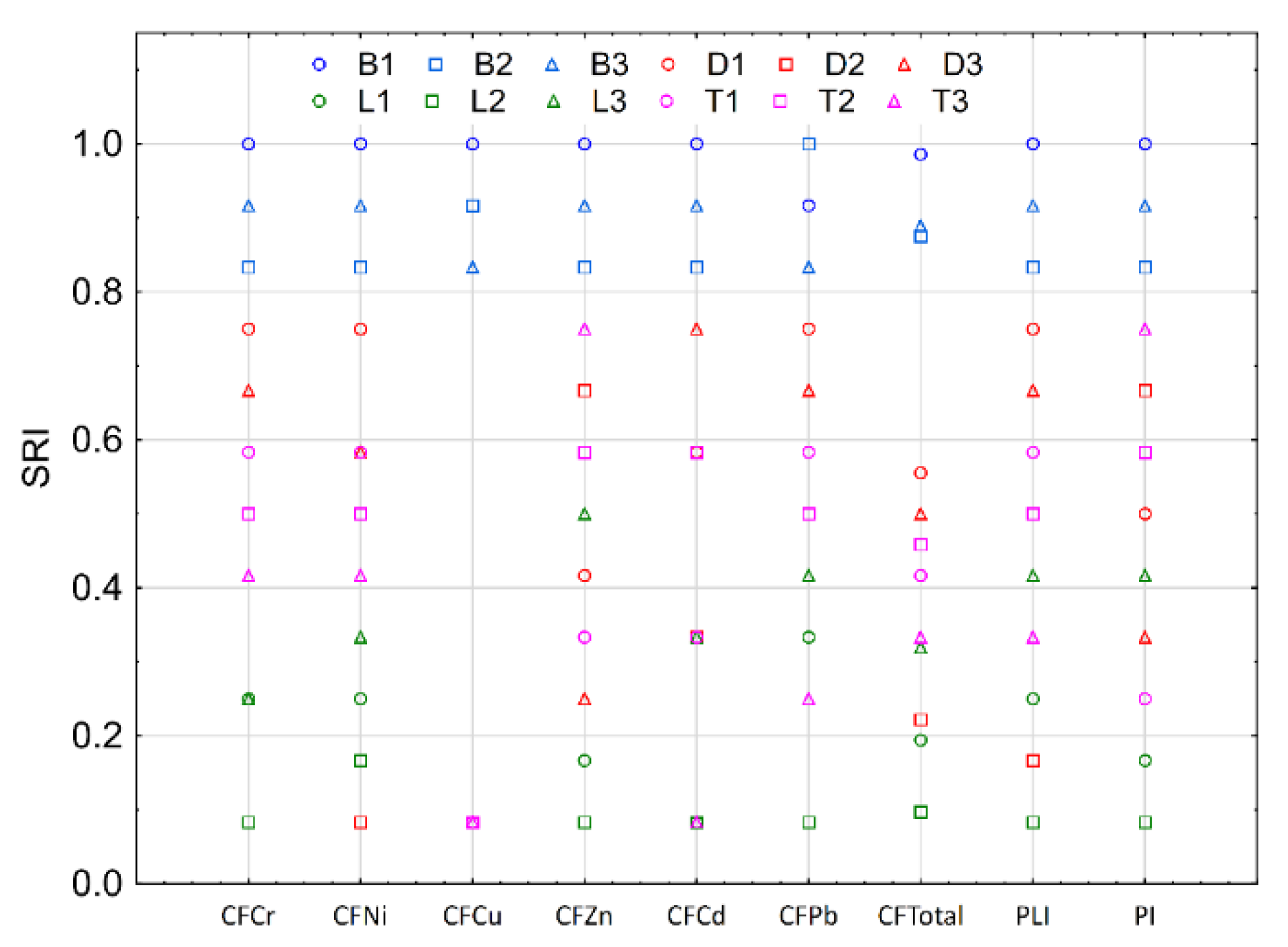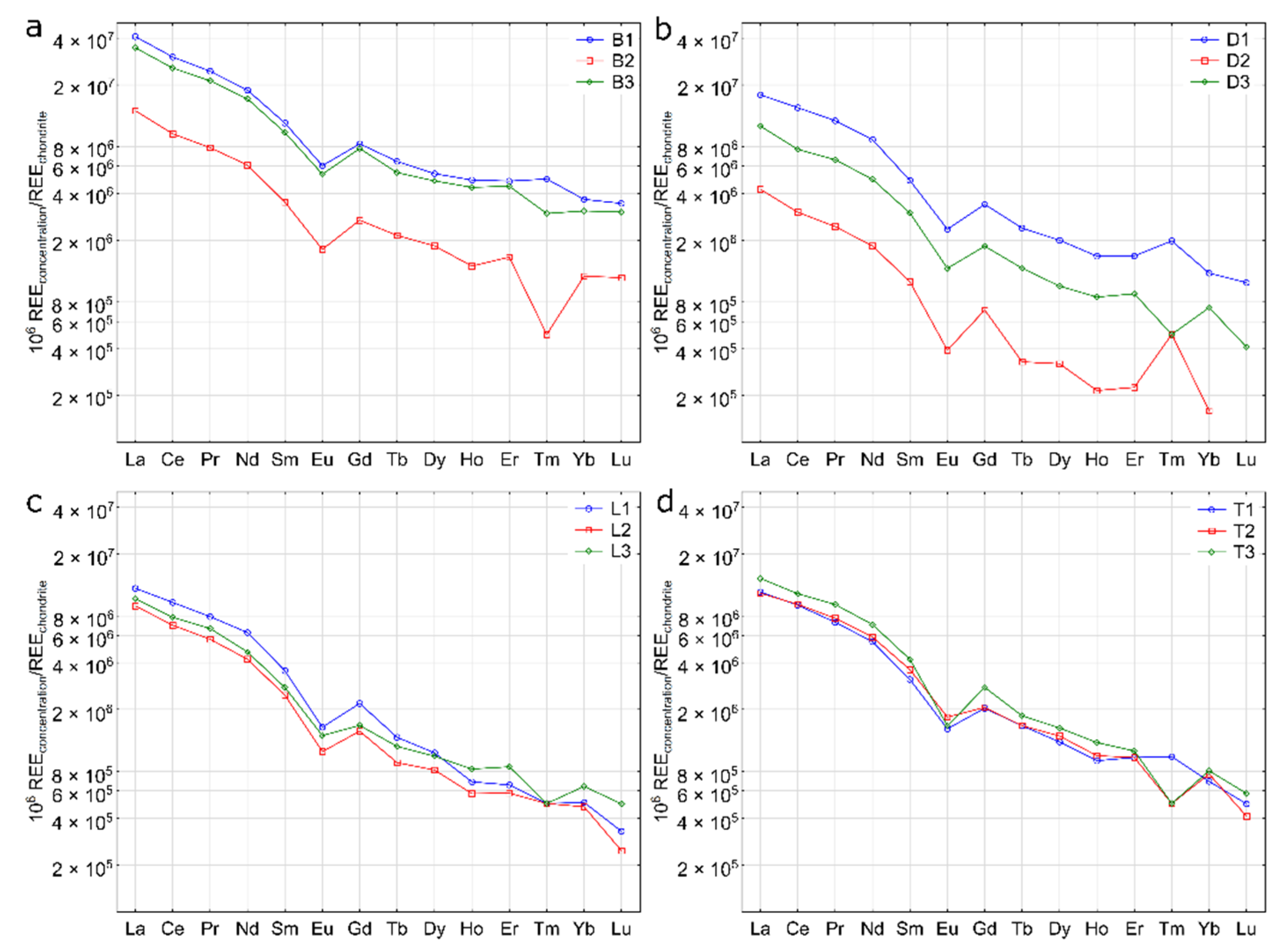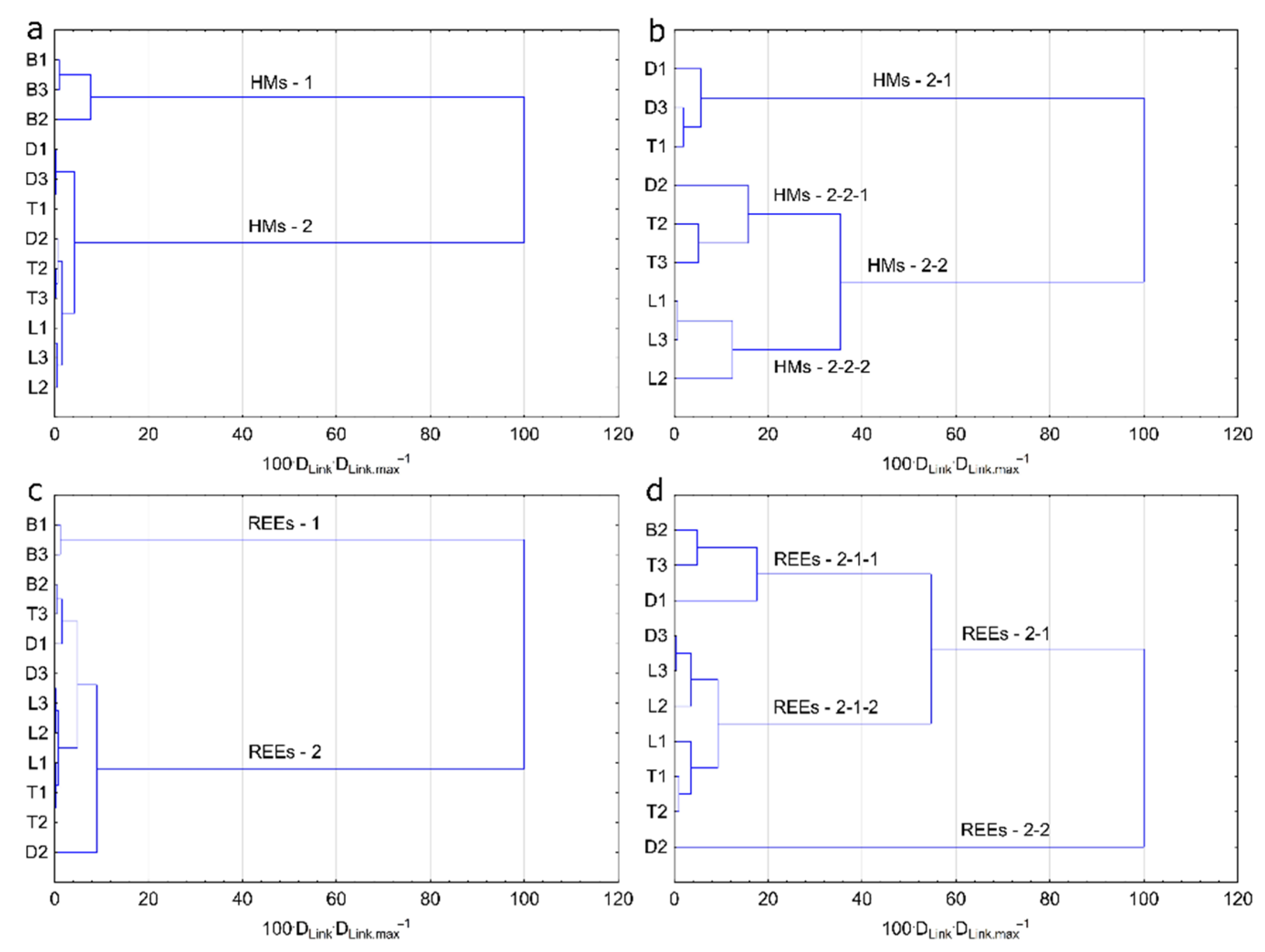Trace Elements in Sediments of Rivers Affected by Brown Coal Mining: A Potential Environmental Hazard
Abstract
:1. Introduction
2. Materials and Methods
2.1. Study Site
2.2. Sample Collection
2.3. Chemical Analysis
2.4. Data Analysis
2.5. Heavy Metal Pollution and Potential Ecotoxicological Risk Assessment
2.6. Rare Earth Element Concentration and Variability
2.7. Statistical Analysis
3. Results
4. Discussion
5. Conclusions
- Mine water discharge can modify concentrations of heavy metals and rare earth elements in sediments, causing a decrease in concentration at sites located close to the mine and an increase concentrations at sites located downstream of the full mixing zone;
- The main factor reducing the concentrations of heavy metals and rare earth elements in sediments is the kinetic energy of the water, which causes the washing away of the fine particles and organic matter;
- Mine water discharges do not change the pattern of individual rare earth elements in sediments;
- Studied sites located downstream of discharge showed a lack of ecological risk according to the presence of metals, except Widawka River, where risk was also observed upstream of mine water discharge;
- Mine waters from surface drainage should be kept longer in settling ponds to reduce total suspended solids with HMs and REEs bonded to them. This requires the creation of settling ponds with increased volume to increase retention time of mine waters;
- The length of full mixing should be limited to enhance river self-purification after the inflow of mine waters to the watercourse.
Supplementary Materials
Author Contributions
Funding
Institutional Review Board Statement
Informed Consent Statement
Conflicts of Interest
References
- Kasztelewicz, Z. Lignite deposits in Poland and perspectives of their utilization. Polityka Energetyczna-Energy Policy J. 2008, 11, 181–200. [Google Scholar]
- Kasztelewicz, Z.; Tajduś, A.; Cała, M.; Ptak, M.; Sikora, M. Strategic conditions for the future of brown coal mining in Poland. Energy Policy J. 2018, 21, 155–178. [Google Scholar] [CrossRef]
- Kasztelewicz, Z.; Tajduś, A.; Słomka, T. Lignite is the fuel of the future or the past. Napedy Sterow. 2017, 7, 88–104. [Google Scholar]
- Kasztelewicz, Z.; Zajączkowski, M. Impact of lignite mining on its surroundings. Energy Policy J. 2010, 13, 227–243. [Google Scholar]
- Przybyłek, J. Current problems of the lignite opencast mines dewatering in the Wielkopolska region. Górnictwo Odkryw. 2018, 59, 5–14. [Google Scholar]
- Pepliński, B.; Czubak, W. The influence of opencast lignite mining dehydration on plant production—A methodological study. Energies 2021, 14, 1917. [Google Scholar] [CrossRef]
- Singh, R.N.; Atkins, A.S.; Pathan, A.G. Determination of ground water quality associated with lignite mining in arid climate. Int. J. Min. Environ. Issues 2010, 1, 65–78. [Google Scholar]
- Staniszewski, R. Heavy Metals in Waters and Sediments of Rivers Affected by Brown Coal Mine Waters. Pol. J. Environ. Stud. 2014, 23, 2217–2222. [Google Scholar] [CrossRef]
- Muthangya, M.; Samoei, D. Status of water quality in the coal rich Mui Basin on Kitui county, Kenya. ARPN J. Earth Sci. 2012, 1, 48–51. [Google Scholar]
- Dulewski, J.; Walter, A. Mine waters management in lignite mines on the background of the whole mining sector. WUG 2007, 6, 5–10. [Google Scholar]
- Staniszewski, R.; Cais-Sokolińska, D.; Kaczyński, Ł.K.; Bielska, P. Use of Bioluminescence for Monitoring Brown Coal Mine Waters from Deep and Surface Drainage. Energies 2021, 14, 3558. [Google Scholar] [CrossRef]
- Staniszewski, R.; Jusik, S. Impact of mine waters discharge from open-pit lignite mine on river water quality. Rocz. Ochr. Srodowiska 2013, 15, 2652–2665. [Google Scholar]
- Tiwari, A.K.; Singh, P.K.; Mahato, M.K. Environmental geochemistry and a quality assessment of mine water of the West Bokaro coalfield, India. Mine Water Environ. 2016, 35, 525–535. [Google Scholar] [CrossRef]
- Tiwari, A.K.; Singh, P.K.; Mahato, M.K. Assessment of metal contamination in the mine water of the West Bokaro Coalfield, India. Mine Water Environ. 2017, 36, 532–541. [Google Scholar] [CrossRef]
- Vasileiou, E.; Perraki, M.; Dmitrakopulos, D. Using leaching tests to investigate mine water contamination. The case study of Open South Lignite Field, Western Macedonia, Greece. FOG-Freib. Online Geosci. 2015, 40, 1–8. [Google Scholar]
- Younger, P.L.; Wolkersdorfer, C. Mining impacts on the fresh water environment: Technical and managerial guidelines for catchment scale management. Mine Water Environ. 2004, 23, 2–80. [Google Scholar] [CrossRef]
- Downing, J. Limnology and oceanography: Two estranged twins reuniting by global change. Inland Waters 2014, 4, 215–232. [Google Scholar] [CrossRef] [Green Version]
- Hancock, S.; Wolkersdorfer, C. Renewed demands for mine water management. Mine Water Environ. 2012, 31, 143–158. [Google Scholar] [CrossRef]
- Skousen, J.G.; Ziemkiewicz, P.F.; McDonald, J.L. Acid mine drainage formation, control and treatment: Approaches and strategies. Extr. Ind. Soc. 2019, 6, 241–249. [Google Scholar] [CrossRef]
- Singh, A.K.; Mahato, M.K.; Neogi, B.; Singh, K.K. Quality assessment of mine water in the Raniganj coalfield area, India. Mine Water Environ. 2010, 29, 248–262. [Google Scholar] [CrossRef]
- Singh, A.K.; Mahato, M.K.; Neogi, B.; Tewary, B.K.; Sinha, A. Environmental geochemistry and quality assessment of mine water of Jharia coalfield, India. Environ. Earth Sci. 2012, 65, 49–65. [Google Scholar] [CrossRef]
- Gao, J.Q.; Yu, Y.; Wang, D.H.; Wang, W.; Wang, C.H.; Dai, H.Z.; Xue-Feng, H.; Cen, K. Effects of lithium resource exploitation on surface water at Jiajika mine, China. Environ. Monit. Assess. 2021, 193, 1–16. [Google Scholar] [CrossRef]
- Mahato, M.K.; Singh, G.; Singh, P.K.; Singh, A.K.; Tiwari, A.K. Assessment of mine water quality using heavy metal pollution index in a coal mining area of Damodar River Basin, India. Bull. Environ. Contam. Toxicol. 2017, 99, 54–61. [Google Scholar] [CrossRef]
- Karina, S.; Suhermi, R.; Alesyah, M.; Octavina, C.; Ulfah, M. Analysis of heavy metals in fluvial sediments affected by coal spill waters in Lampuuk Beach, Aceh Province, Indonesia. IOP Conf. Ser. Earth Environ. Sci. 2019, 348, 012085. [Google Scholar] [CrossRef]
- Filgueiras, A.V.; Lavilla, I.; Bendicho, C. Evaluation of distribution, mobility and binding behaviour of heavy metals in surficial sediments of Louro River (Galicia, Spain) using chemometric analysis: A case study. Sci. Total Environ. 2004, 330, 115–129. [Google Scholar] [CrossRef]
- Joksimovic, D.; Tomic, I.; Stankovic, A.R.; Jovic, M.; Stankovic, S. Trace metal concentrations in Mediterranean blue mussel and surface sediments and evaluation of the mussels quality and possible risks of high human consumption. Food Chem. 2011, 127, 632–637. [Google Scholar] [CrossRef]
- Luoma, S.N.; Bryan, G.W. A statistical assessment of the form of trace metals in oxidized estuarine sediments employing chemical extractants. Sci. Total Environ. 1981, 17, 165–196. [Google Scholar] [CrossRef]
- Friedland, G.; Grüneberg, B.; Hupfer, M. Geochemical signatures of lignite mining products in sediments downstream a fluvial-lacustrine system. Sci. Total Environ. 2021, 760, 143942. [Google Scholar] [CrossRef]
- Miller, V.S.; Naeth, M.A.; Wilkinson, S.R. Micro topography, organic amendments and an erosion control product for reclamation of waste materials at an arctic diamond mine. Ecol. Eng. 2021, 172, 106399. [Google Scholar] [CrossRef]
- Policht-Latawiec, A.; Kapica, A. Influence of Hard Coal Mine on Water Quality in the Vistula River. Rocz. Ochr. Srodowiska 2013, 15, 2640–2651. [Google Scholar]
- Pietrzyk-Sokulska, E.; Uberman, R.; Kulczycka, J. The impact of mining on the environment in Poland–Myths and reality. Gospod. Surowcami Miner. 2015, 31, 45–64. [Google Scholar] [CrossRef] [Green Version]
- Kondracki, J. Regional Geography of Poland; PWN: Warsaw, Poland, 2013; p. 444. [Google Scholar]
- Ziernicka-Wojtaszek, A.; Kopcińska, J. Variation in atmospheric precipitation in Poland in the years 2001–2018. Atmosphere 2020, 11, 794. [Google Scholar] [CrossRef]
- Martin, J.M.; Meybeck, M. Elemental mass-balance of material carried by major world rivers. Mar. Chem. 1979, 7, 173–206. [Google Scholar] [CrossRef]
- Tomlinson, D.L.; Wilson, J.G.; Harris, C.R.; Jeffrey, D.W. Problems in the assessment of heavy-metal levels in estuaries and the formation of a pollution index. Helgoländer Meeresunters. 1980, 33, 566–575. [Google Scholar] [CrossRef] [Green Version]
- Nemerow, N.L. Stream, Lake, Estuary, and Ocean Pollution; Van Nostrand Reinhold: New York, NY, USA, 1991. [Google Scholar]
- Yan, N.; Liu, W.; Xie, H.; Gao, L.; Han, Y.; Wang, M.; Li, H. Distribution and assessment of heavy metals in the surface sediment of Yellow River, China. J. Environ. Sci. 2016, 39, 45–51. [Google Scholar] [CrossRef]
- Hakanson, L. An ecological risk index for aquatic pollution control: A sediment ecological approach. Water Res. 1980, 14, 975–1001. [Google Scholar] [CrossRef]
- Bojakowska, I.; Sokołowska, G. Geochemical quality classes of aquatic sediments. Prz. Geol. 1998, 46, 49–54. [Google Scholar]
- Omwene, P.I.; Öncel, M.S.; Çelen, M.; Kobya, M. Heavy metal pollution and spatial distribution in surface sediments of Mustafakemalpaşa stream located in the world’s largest borate basin (Turkey). Chemosphere 2018, 208, 782–792. [Google Scholar] [CrossRef]
- Zhang, H.; Zeng, H.; Jiang, Y.; Xie, Z.; Xu, X.; Ding, M.; Wang, P. Using the compound system to synthetically evaluate the enrichment of heavy metal (loid) s in a subtropical basin, China. Environ. Pollut. 2020, 256, 113396. [Google Scholar] [CrossRef]
- Custodio, M.; Fow, A.; Chanamé, F.; Orellana-Mendoza, E.; Peñaloza, R.; Alvarado, J.C.; Cano, D.; Pizarro, S. Ecological Risk Due to Heavy Metal Contamination in Sediment and Water of Natural Wetlands with Tourist Influence in the Central Region of Peru. Water 2021, 13, 2256. [Google Scholar] [CrossRef]
- Nakamura, N. Determination of REE, Ba, Fe, Mg, Na and K in carbonaceous and ordinary chondrites. Geochim. Cosmochim. Acta 1974, 38, 757–775. [Google Scholar] [CrossRef]
- Bau, M.; Dulski, P. Anthropogenic origin of positive gadolinium anomalies in river waters. Earth Planet. Sci. Lett. 1996, 143, 245–255. [Google Scholar] [CrossRef]
- de Baar, H.J.; German, C.R.; Elderfield, H.; Van Gaans, P. Rare earth element distributions in anoxic waters of the Cariaco Trench. Geochim. Cosmochim. Acta 1988, 52, 1203–1219. [Google Scholar] [CrossRef]
- Sholkovitz, E.R. The aquatic chemistry of rare earth elements in rivers and estuaries. Aquat. Geochem. 1995, 1, 1–34. [Google Scholar] [CrossRef]
- Benabdelkader, A.; Taleb, A.; Probst, J.L.; Belaidi, N.; Probst, A. Origin, distribution, and behaviour of rare earth elements in river bed sediments from a carbonate semi-arid basin (Tafna River, Algeria). Appl. Geochem. 2019, 106, 96–111. [Google Scholar] [CrossRef] [Green Version]
- Sojka, M.; Siepak, M.; Pietrewicz, K. Concentration of rare earth elements in surface water and bottom sediments in lake Wadąg, Poland. J. Elem. 2019, 24, 125–140. [Google Scholar]
- Li, S.; Zhang, Q. Spatial characterization of dissolved trace elements and heavy metals in the upper Han River (China) using multivariate statistical techniques. J. Hazard. Mater. 2010, 176, 579–588. [Google Scholar] [CrossRef]
- Ter Braak, C.; Smilauer, P. CANOCO Reference Manual and User’s Guide to Canoco for Windows. Software for Canonical Community Ordination, version 4.5; Canoco: Ithaca, NY, USA, 2002. [Google Scholar]
- Liu, C.W.; Lin, K.H.; Kuo, Y.M. Application of factor analysis in the assessment of groundwater quality in a blackfoot disease area in Taiwan. Sci. Total Environ. 2003, 313, 77–89. [Google Scholar] [CrossRef]
- Singh, A.K.; Mahato, M.K.; Neogi, B.; Mondal, G.C.; Singh, T.B. Hydrogeochemistry, elemental flux, and quality assessment of mine water in the Pootkee-Balihari mining area, Jharia coalfield, India. Mine Water Environ. 2011, 30, 197. [Google Scholar] [CrossRef]
- Wolkersdorfer, C.; Mugova, E. Effects of Mining on Surface Water. In Encyclopedia of Inland Waters, 2nd ed.; Elsevier: Amsterdam, The Netherlands, 2021. [Google Scholar]
- Samecka-Cymerman, A.; Kempers, A.J. Concentrations of heavy metals and plant nutrients in water, sediments and aquatic macrophytes of anthropogenic lakes (former open cut brown coal mines) differ in stage of acidification. Sci. Total Environ. 2001, 281, 87–98. [Google Scholar] [CrossRef]
- Moschini-Carlos, V.; Pompêo, M.L.M.; Lobo, F.D.L.; Meirelles, S.T. Impact of coal mining on water quality of three artificial lakes in Morozini River Basin (Treviso, Santa Catarina State, Brazil). Acta Limnol. Bras. 2011, 23, 271–281. [Google Scholar] [CrossRef] [Green Version]
- Frankowski, M.; Sobczyński, T.; Zioła, A. The effect of grain size structure on the content of heavy metals in alluvial sediments of the Odra River. Pol. J. Environ. Stud. 2005, 14, 81–86. [Google Scholar]
- Bianchini, F.; Pascali, G.; Campo, A.; Orecchio, S.; Bonsignore, R.; Blandino, P.; Pietrini, P. Elemental contamination of an open-pit mining area in the Peruvian Andes. Int. J. Environ. Sci. Technol. 2015, 12, 1065–1074. [Google Scholar] [CrossRef] [Green Version]
- Sojka, M.; Siepak, M.; Jaskuła, J.; Wicher-Dysarz, J. Heavy Metal Transport in a River-Reservoir System: A Case Study from Central Poland. Pol. J. Environ. Stud. 2018, 27, 1725–1734. [Google Scholar] [CrossRef]
- Sojka, M.; Siepak, M.; Gnojska, E. Assessment of heavy metal concentration in bottom sediments of Stare Miasto pre-dam reservoir on the Powa River. Rocz. Ochr. Srodowiska 2013, 15, 1916–1928. [Google Scholar]
- Sojka, M.; Jaskuła, J.; Siepak, M. Heavy metals in bottom sediments of reservoirs in the lowland area of western Poland: Concentrations, distribution, sources and ecological risk. Water 2018, 11, 56. [Google Scholar] [CrossRef] [Green Version]
- Frankowski, M.; Sojka, M.; Zioła-Frankowska, A.; Siepak, M.; Murat-Błażejewska, S. Distribution of heavy metals in the Mała Wełna River system (western Poland). Oceanol. Hydrobiol. Stud. 2009, 38, 51–61. [Google Scholar] [CrossRef]
- Staniszewski, R.; Diatta, J.B.; Andrzejewska, B. Impact of lignite mine waters from deep seated drainage on water quality of the Noteć River. J. Elem. 2014, 19, 749–758. [Google Scholar] [CrossRef]
- Samecka-Cymerman, A.; Kempers, A.J. Heavy metals in aquatic macrophytes from two small rivers polluted by urban, agricultural and textile industry sewages SW Poland. Arch. Environ. Contam. Toxicol. 2007, 53, 198–206. [Google Scholar] [CrossRef]
- Khan, R.; Israili, S.H.; Ahmad, H.; Mohan, A. Heavy Metal Pollution Assessment in Surface Water Bodies and its Suitability for Irrigation around the Neyevli Lignite Mines and Associated Industrial Complex, Tamil Nadu, India. Mine Water Environ. 2005, 24, 155–161. [Google Scholar] [CrossRef]
- Kruk, A. Long-term changes in fish assemblages of the Widawka and Grabia Rivers (Poland): Pattern recognition with a Kohonen artificial neural network. Ann. Limnol.-Int. J. Limnol. 2007, 43, 253–269. [Google Scholar] [CrossRef] [Green Version]
- Sojka, M. Directions and Extent of Flows Changes in Warta River Basin (Poland) in the Context of the Efficiency of Run-of-River Hydropower Plants and the Perspectives for Their Future Development. Energies 2022, 15, 439. [Google Scholar] [CrossRef]
- Sojka, M.; Siepak, M.; Zioła, A.; Frankowski, M.; Murat-Błażejewska, S.; Siepak, J. Application of multivariate statistical techniques to evaluation of water quality in the Mała Wełna River (Western Poland). Environ. Monit. Assess. 2008, 147, 159–170. [Google Scholar] [CrossRef]
- Jaskuła, J.; Sojka, M.; Fiedler, M.; Wróżyński, R. Analysis of spatial variability of river bottom sediment pollution with heavy metals and assessment of potential ecological hazard for the Warta river, Poland. Minerals 2021, 11, 327. [Google Scholar] [CrossRef]
- Jaskuła, J.; Sojka, M. Assessment of spatial distribution of sediment contamination with heavy metals in the two biggest rivers in Poland. Catena 2022, 211, 105959. [Google Scholar] [CrossRef]
- Salah, E.; Zaidan, T.; Al-Rawi, A. Assessment of Heavy Metals Pollution in the Sediments of Euphrates River, Iraq. J. Water Resour. Prot. 2012, 4, 1009–1023. [Google Scholar] [CrossRef] [Green Version]
- Andem, A.B.; Okorafor, K.A.; Oku, E.E.; Ugwumba, A.A. Evaluation and Characterization of Trace Metals Contamination in the Surface Sediment Using Pollution Load Index (PLI) and Geo-Accumulation Index (Igeo) of Ona River, Western Nigeria. Int. J. Sci. Technol. Res. 2015, 4, 29–34. [Google Scholar]
- Shrivastava, V. Geochemical Assessment of Heavy Metal Pollution and Toxicity of Kunda River Sediment at Khargone District, Madhya Pradesh, India. Int. J. Eng. Res. Technol. 2014, 3, 329–333. [Google Scholar]
- Wachowiak, G.; Galiniak, G.; Jończyk, W.; Martyniak, R. Evaluation of the outflow changes in Widawka River catchment in the hydrological year 2010 under the impact of a mining and energetic investments in Bełchatów area. Górnictwo Geoinżynieria 2011, 35, 381–395. [Google Scholar]
- Liu, D.; Wang, J.; Yu, H.; Gao, H.; Xu, W. Evaluating ecological risks and tracking potential factors influencing heavy metals in sediments in an urban river. Environ. Sci. Eur. 2021, 33, 42. [Google Scholar] [CrossRef]
- Ganai, J.A.; Rashid, S.A. Rare earth element geochemistry of the Permo-Carboniferous clastic sedimentary rocks from the Spiti Region, Tethys Himalaya: Significance of Eu and Ce anomalies. Chin. J. Geochem. 2015, 34, 252–264. [Google Scholar] [CrossRef]
- Sojka, M.; Choiński, A.; Ptak, M.; Siepak, M. Causes of variations of trace and rare earth elements concentration in lakes bottom sediments in the Bory Tucholskie National Park, Poland. Sci. Rep. 2021, 11, 1–18. [Google Scholar] [CrossRef] [PubMed]






| Index | B1 | B2 | B3 | D1 | D2 | D3 | L1 | L2 | L3 | T1 | T2 | T3 |
|---|---|---|---|---|---|---|---|---|---|---|---|---|
| Pollution assessment | ||||||||||||
| CFCr | 2.64 | 0.76 | 1.87 | 0.57 | 0.02 | 0.42 | 0.11 | 0.02 | 0.11 | 0.31 | 0.19 | 0.15 |
| CFNi | 14.09 | 4.88 | 9.93 | 0.60 | 0.08 | 0.38 | 0.14 | 0.11 | 0.19 | 0.38 | 0.25 | 0.21 |
| CFCu | 2.47 | 1.48 | 1.34 | 0.02 | 0.02 | 0.02 | 0.02 | 0.02 | 0.02 | 0.02 | 0.02 | 0.02 |
| CFZn | 5.48 | 2.15 | 4.20 | 0.96 | 1.44 | 0.93 | 0.89 | 0.65 | 0.97 | 0.94 | 1.42 | 1.46 |
| CFCd | 1.30 | 0.23 | 0.99 | 0.08 | 0.05 | 0.10 | 0.03 | 0.03 | 0.05 | 0.05 | 0.08 | 0.03 |
| CFPb | 1.82 | 1.87 | 1.38 | 0.22 | 0.05 | 0.20 | 0.08 | 0.05 | 0.09 | 0.16 | 0.15 | 0.07 |
| PLI | 3.25 | 1.32 | 2.29 | 0.21 | 0.07 | 0.19 | 0.09 | 0.06 | 0.11 | 0.16 | 0.16 | 0.11 |
| PI | 10.49 | 3.70 | 7.39 | 0.74 | 1.04 | 0.70 | 0.65 | 0.47 | 0.71 | 0.70 | 1.04 | 1.06 |
| Ecological risk assessment | ||||||||||||
| ERCr | 5.3 | 1.5 | 3.7 | 1.1 | 0.0 | 0.8 | 0.2 | 0.0 | 0.2 | 0.6 | 0.4 | 0.3 |
| ERNi | 70.4 | 24.4 | 49.6 | 3.0 | 0.4 | 1.9 | 0.7 | 0.6 | 0.9 | 1.9 | 1.3 | 1.1 |
| ERCu | 12.4 | 7.4 | 6.7 | 0.1 | 0.1 | 0.1 | 0.1 | 0.1 | 0.1 | 0.1 | 0.1 | 0.1 |
| ERZn | 5.5 | 2.2 | 4.2 | 1.0 | 1.4 | 0.9 | 0.9 | 0.7 | 1.0 | 0.9 | 1.4 | 1.5 |
| ERCd | 39.0 | 7.0 | 29.6 | 2.3 | 1.6 | 3.1 | 0.8 | 0.8 | 1.6 | 1.6 | 2.3 | 0.8 |
| ERPb | 9.1 | 9.4 | 6.9 | 1.1 | 0.2 | 1.0 | 0.4 | 0.2 | 0.5 | 0.8 | 0.8 | 0.3 |
| PERI | 141.6 | 51.8 | 100.8 | 8.6 | 3.7 | 7.8 | 3.1 | 2.4 | 4.3 | 5.9 | 6.2 | 4.0 |
Publisher’s Note: MDPI stays neutral with regard to jurisdictional claims in published maps and institutional affiliations. |
© 2022 by the authors. Licensee MDPI, Basel, Switzerland. This article is an open access article distributed under the terms and conditions of the Creative Commons Attribution (CC BY) license (https://creativecommons.org/licenses/by/4.0/).
Share and Cite
Staniszewski, R.; Niedzielski, P.; Sobczyński, T.; Sojka, M. Trace Elements in Sediments of Rivers Affected by Brown Coal Mining: A Potential Environmental Hazard. Energies 2022, 15, 2828. https://doi.org/10.3390/en15082828
Staniszewski R, Niedzielski P, Sobczyński T, Sojka M. Trace Elements in Sediments of Rivers Affected by Brown Coal Mining: A Potential Environmental Hazard. Energies. 2022; 15(8):2828. https://doi.org/10.3390/en15082828
Chicago/Turabian StyleStaniszewski, Ryszard, Przemysław Niedzielski, Tadeusz Sobczyński, and Mariusz Sojka. 2022. "Trace Elements in Sediments of Rivers Affected by Brown Coal Mining: A Potential Environmental Hazard" Energies 15, no. 8: 2828. https://doi.org/10.3390/en15082828






